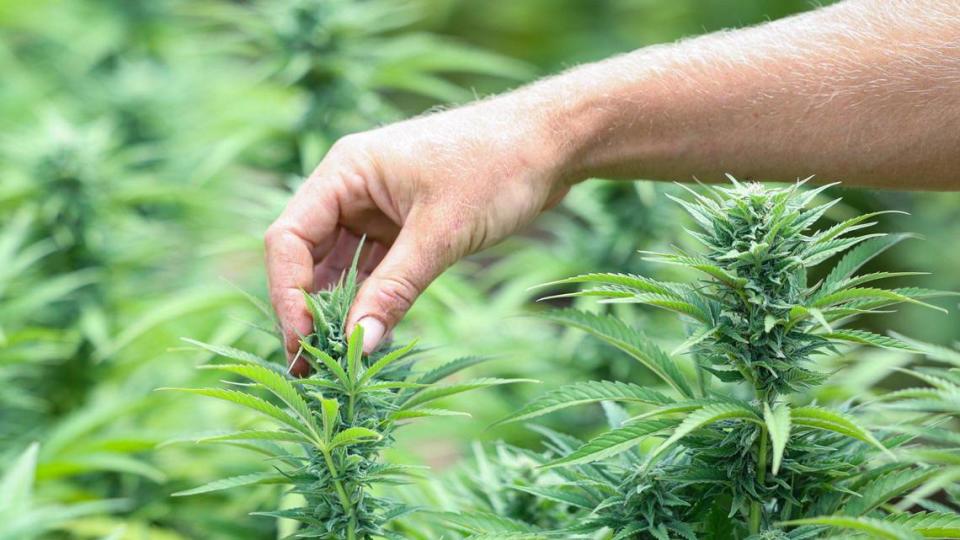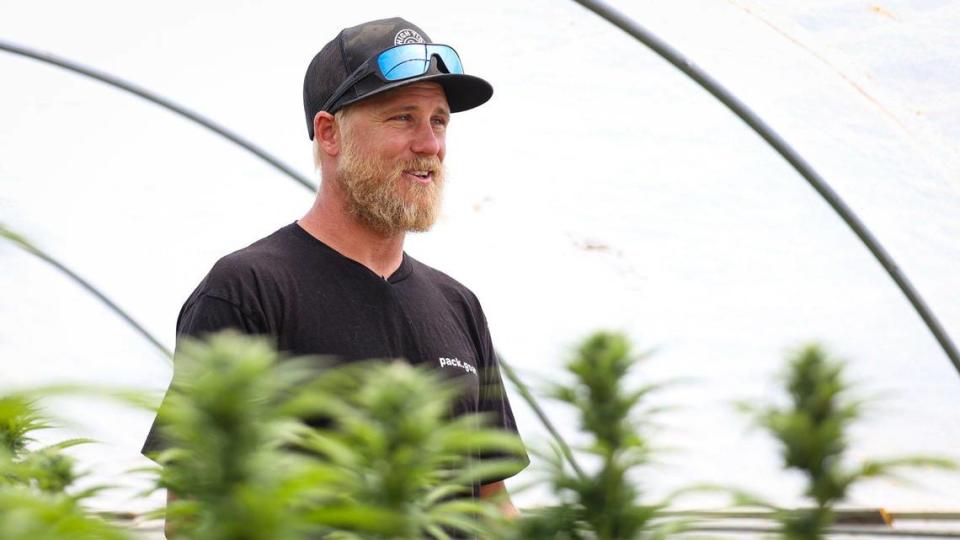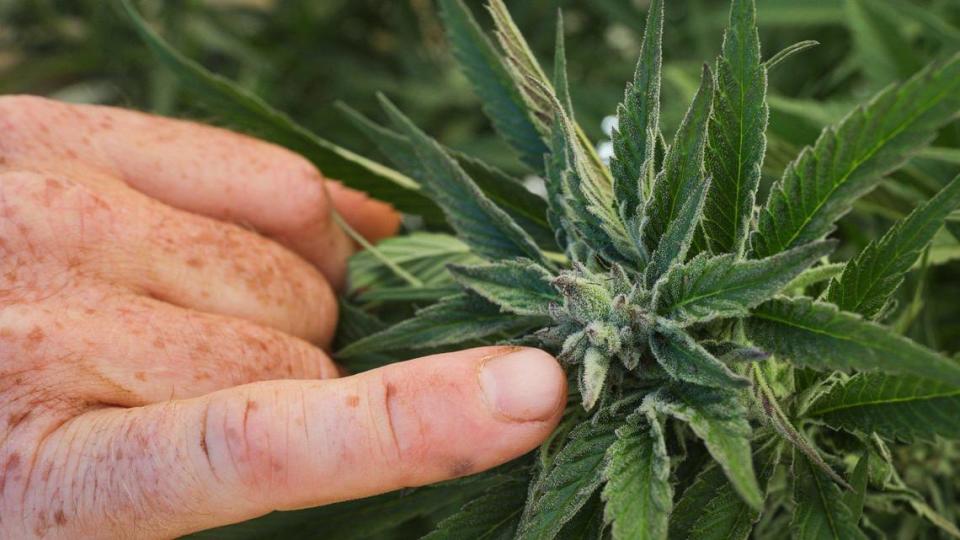Cannabis in crisis: Struggling SLO County businesses ask for fewer fees, regulations
On a remote hill above Cayucos, two farmers and their crew work 12-hour days tending to more than 50 varietals of cannabis.
“Everyone thinks it’s really easy to grow weed or we’re just a bunch of stoners out here, and that’s not the case,” Terp Canyon co-owner Justin Carlson said. “We’re hard-working people.”
Each varietal of cannabis is grown in its own hoop house labeled for the plant’s flavor and scent — which range from “Froot Loops” to “gassy apple.”
Carlson chose Cayucos for the farm because cool air from the ocean traps the flavor in the plant, while heat strips flavor away, he said.
“We’re here 12 hours a day to make it work because we love it,” he added. “We put our love and passion into our product.”
Though Carlson enjoys growing cannabis and sharing his product, San Luis Obispo County regulations strangle his business, he said.
“We’re just struggling to make it,” Carlson said. “In SLO County, we just have some of the obstacles with regulations taking away some of the tools we need to be successful.”

SLO County Sheriff’s Office responsible for code enforcement
In 2018, SLO County voters passed Measure B-18, which created a tax on the gross receipts of each cannabis business in unincorporated areas of the county.
The tax was designed to cover the cost of regulating the cannabis industry, from inspecting properties to processing permits.
But the tax didn’t generate enough revenue to cover the cost of services — during the 2020-21 fiscal year, cannabis business tax revenue generated only $518,130, according to SLO County Planning Department Deputy Director Mark LaRue.
So the county dipped into the general fund to pick up the difference, according to San Luis Obispo County Sheriff’s Office Cmdr. Ian Doughty.
In September 2022, the San Luis Obispo County Board of Supervisors voted to create a division in the Sheriff’s Office to manage cannabis code enforcement as a sort of “cost-recovery unit,” Doughty said.
The Cannabis Compliance Team, comprised of two sheriff’s detectives and three county code enforcement officers, is funded by fees paid directly by cannabis operators, Doughty said.

The team inspects each cannabis operation quarterly to check if it is in compliance with county and state cannabis rules.
According to cannabis business owner Shawn Bean, inspections are “a pretty painless process.”
Bean owns a delivery business in Nipomo called The Source Central Coast. Each delivery vehicle has a GPS tracking device inside of it, and during a site inspection, the sheriff’s deputy will review the GPS data.
He said his business has a positive relationship with the deputies.
“The deputies are very easy to work with,” Bean said. “They’re there to help. They return phone calls, reply to emails quickly.”
Doughty said when the unit discovers a code violation, they work with the operator to fix the problem.
“If we identify issues, our goal is to get them into compliance,” Doughty said. “I like to think we have a good, professional working relationship.”
Fees, ‘a lot of steps’ complicate cannabis program
Carlson said he appreciates working with the Sheriff’s Office, too — but the challenging part of the program is the cost of the fees.
When enforcement passed to the Sheriff’s Office, Terp Canyon’s annual fees jumped from $4,800 to $18,000, Carlson said.
Fees related to the Sheriff’s Office include an initial background check for $12,600, an annual license renewal of $18,702 for cultivation projects and $15,441 for non-cultivation projects, annual inspection fees of $11,570 for cultivation projects and $9,423 for non-cultivation projects and $628 background checks for employees, according to LaRue.
“The Sheriff’s Office has been really supportive of what we’re doing out here. They want us to succeed,” Carlson said. “I think that their hands are tied by the rules set in place by the county — they can only help us so much, even if they want to.”

Not all counties operate this way, however.
In Santa Barbara County, code enforcement is handled primarily by the Planning and Development Department and the Sheriff’s Office — and their efforts are funded entirely by the cannabis business tax, according to Santa Barbara County Deputy County Executive Officer Brittany Odermann.
While SLO County has a 6% cannabis tax on gross receipts for all cannabis businesses, Santa Barbara County has a 1% tax for nurseries, a 4% tax for cultivators and a 6% tax for retailers, according to Odermann.
Santa Barbara County’s cannabis business tax brings in far more revenue than SLO County’s. In fiscal year 2021-22, Santa Barbara County’s tax generated $8,718,776, while SLO County’s brought in $348,840.
This is partly because more cannabis grows in Santa Barbara County.
SLO County has about 25 acres of outdoor cannabis cultivation, according to LaRue. Meanwhile, Santa Barbara County has between 450 and 500 acres of licensed cannabis cultivation, Odermann said.
In San Luis Obispo County, the Sheriff’s Office manages code enforcement, the Planning and Building Department manages land use approval and the Tax Collector approves business licenses, Doughty said.
“There’s still a lot of steps,” Doughty said. “Our goal is to make it a simpler program.”
Meanwhile, cannabis laws are constantly changing at both the state and local level, Doughty said, which is challenging for operators and the Sheriff’s Office to keep up with.
Doughty said he hopes that uniting code enforcement officers and sheriff’s deputies into one program will help the county streamline the enforcement process so it’s more efficient and affordable for operators.
“Cannabis laws have changed substantially over the last handful of years, and it has been a changing landscape,” Doughty said. “What I’d like to do with our program is try to stabilize that on our end and try to establish some consistency.”

County regulations stress cannabis operators
In the meantime, cannabis growers face other regulatory hurdles that make it difficult to run their businesses.
For example, in San Luis Obispo County, cannabis growers can’t store their product on site once its harvested.
“It can’t even stay here overnight,” Carlson said.
This means that on harvest days, Carlson and his team immediately must pack the product into a freezer van, which moves the harvested cannabis to an off-site storage facility in Long Beach.
“It just adds steps, adds expenses,” Carlson said. “If we could store our product (on site), we’d be sitting in a way better place financially.”
“Our whole goal in this struggling market is to try to get our cost down, but without sacrificing the quality of our product,” Carlson said.
Growers aren’t the only cannabis businesses looking for changes in county regulations.
Right now, only cannabis delivery is allowed in unincorporated areas of the county, but Bean said he thinks the board should authorize brick-and-mortar cannabis shops, too.
Bean’s company delivers cannabis products all over the county, but the county can only collect taxes on sales made in unincorporated areas. So when Bean delivers cannabis in Paso Robles, the county doesn’t receive any tax revenue.
“Say you put one in Nipomo where I’m at, and you have all those people driving up from Santa Maria and SLO,” Bean said. “All of the people that were to stop there, the county would collect all of that tax revenue.”
If the county collected more tax revenue, businesses wouldn’t need to pay separate code enforcement fees, Bean said, which would reduce stress on operators.
“It’s just time to make a change,” Carlson said. “Maybe those rules worked beforehand when this industry first started, but at this point, it’s a completely different game.”

